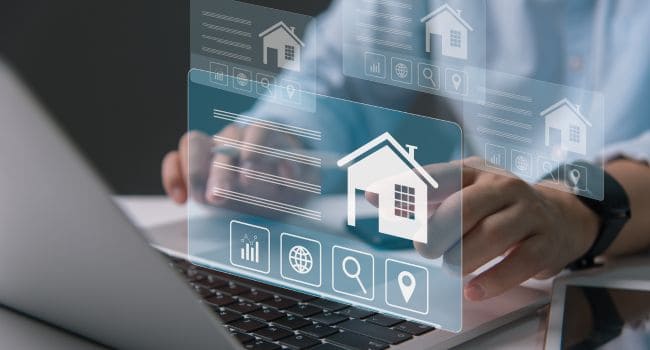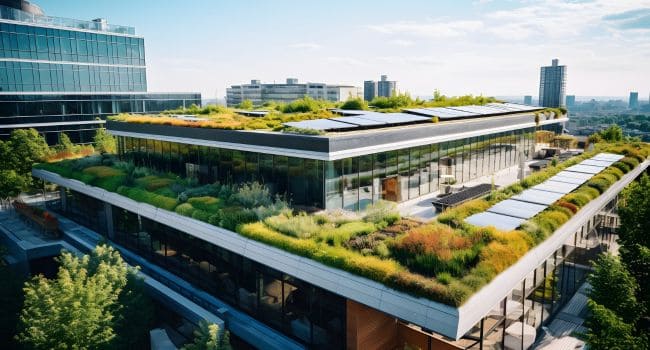
Sustainable commercial real estate is rapidly becoming a priority in investment strategies. As demand in industrial and multifamily sectors grows and office and retail spaces face uncertainty, sustainability is shifting from a desirable feature to a crucial investment criterion for long-term value and resilience.
For investors, this shift is more than an environmental statement; it’s a strategic imperative. Embracing green building practices, eco-friendly construction, and smart technologies is not just about sustainability, but also about enhancing asset value and aligning with evolving market preferences.
This article offers a detailed analysis into the commercial real estate market, emphasizing its sustainable evolution. We’ll explore sector-specific adaptations, economic impacts for investors, and the transformative trends shaping this space. Let’s explore the sustainable future of commercial real estate, where environmental responsibility converges with economic opportunity.

The industrial sector of U.S. commercial real estate is experiencing a robust phase, primarily driven by the meteoric rise of e-commerce. This digital shopping revolution has significantly increased the demand for warehousing and logistics spaces. Companies are aggressively seeking out industrial properties to facilitate faster delivery times and manage inventory more efficiently, leading to low vacancy rates and a notable increase in rental prices. This sector’s strength is a direct reflection of the evolving consumer behavior favoring online shopping, making it a lucrative area for real estate investors.
while showing growth potential, is navigating mixed signals in the current market. Demographic shifts and lifestyle changes, such as the increasing preference for renting among young professionals and smaller households, support this sector’s potential. However, factors like rising interest rates and inflation are impacting rental affordability and reshaping demand.In some urban and suburban areas, demand for multifamily housing remains strong, keeping vacancy rates low and rental incomes steady. However, the trend towards remote work and a preference for larger living spaces are reshaping demand, especially in densely populated regions. Investors in the multifamily sector should adopt a cautious stance, balancing the opportunities in demographically strong markets with the risks posed by economic uncertainties and evolving consumer preferences.
The office sector is facing significant challenges in the wake of the global shift towards remote work. The pandemic has accelerated the adoption of work-from-home policies, leading many businesses to reevaluate their need for physical office spaces. This shift has resulted in increased vacancy rates and a softening of rental prices in the office real estate market. Investors in this sector are now tasked with reimagining office spaces to make them more appealing in a post-pandemic world, focusing on flexibility, health, and safety.
The retail sector of commercial real estate is undergoing a period of adjustment, primarily due to the rise of e-commerce. Traditional brick-and-mortar retail spaces are facing challenges as consumer shopping habits increasingly shift online. This change has led to higher vacancy rates and a decrease in rental values for retail properties. Retail real estate investors are now exploring new strategies, such as repurposing spaces for experiential retail or mixed-use developments, to stay relevant in the changing landscape.
Despite the challenges faced by the office and retail sectors, the overall outlook for the commercial real estate market remains positive. The strength of the industrial and multifamily sectors is a significant counterbalance to the headwinds faced elsewhere. Investors are advised to stay informed about these sector-specific trends and adapt their strategies accordingly to navigate the dynamic landscape of commercial real estate effectively.

Sustainable commercial real estate refers to properties designed, built, and operated in an environmentally responsible and resource-efficient manner throughout their life cycle. This concept extends beyond mere energy efficiency to encompass various aspects of sustainability, including water conservation, use of sustainable materials, and creating healthier indoor environments.
The importance of sustainable commercial real estate cannot be overstated. It represents a crucial step towards addressing global environmental challenges such as climate change and resource depletion. Sustainable buildings not only help in reducing carbon footprints but also offer economic benefits. They tend to have lower operating costs due to energy efficiency, attract premium tenants who are increasingly environmentally conscious, and often command higher rental rates and property values.
In the modern real estate market, sustainability is rapidly becoming a significant factor influencing the value and demand of commercial properties. Investors, tenants, and regulatory bodies are increasingly prioritizing environmental responsibility. Properties that meet these sustainability standards are often more attractive to a growing segment of the market that values eco-friendliness and energy efficiency.
This shift is not just driven by environmental concerns but also by economic incentives. Sustainable buildings often result in lower utility costs, reduced maintenance expenses, and improved occupant health and productivity, which are attractive features for potential tenants and buyers. As a result, these properties tend to have higher occupancy rates and can provide a competitive edge in the market.
Green building certifications, such as LEED (Leadership in Energy and Environmental Design), BREEAM (Building Research Establishment Environmental Assessment Method), and WELL, play a pivotal role in enhancing the appeal of commercial properties. These certifications serve as a benchmark for sustainability and are a visible testament to a building’s environmental performance.
Eco-friendly construction methods and materials are integral to achieving these certifications. They include the use of renewable energy sources, energy-efficient lighting and HVAC systems, water-saving fixtures, and materials that are sustainably sourced and have low environmental impact. The incorporation of green spaces, such as rooftop gardens and indoor plants, also contributes to the sustainability and aesthetic appeal of commercial properties.
The integration of sustainable practices in commercial real estate is not just a trend but a necessary evolution. By embracing sustainability, developers and investors not only contribute to environmental conservation, but also tap into a market that increasingly values and rewards green and energy-efficient properties as awareness and regulations surrounding environmental impact continue to grow.
The industrial sector, particularly warehousing and logistics, is undergoing a significant transformation with sustainability at its core. The rise of e-commerce has not only increased the demand for warehouse space but also highlighted the need for environmentally responsible practices. Sustainable warehousing incorporates energy-efficient designs, renewable energy sources, and green materials, reducing the carbon footprint and operational costs. Additionally, logistics companies are increasingly adopting eco-friendly transportation methods and optimizing supply chains for reduced environmental impact. These sustainable practices not only contribute to environmental conservation but also enhance the long-term value and appeal of industrial real estate assets.
In the multifamily sector, the trend towards eco-friendly living is gaining momentum. Developers are increasingly focusing on building apartment complexes that are not just aesthetically pleasing but also environmentally responsible. These complexes often feature energy-efficient appliances, water-saving fixtures, and use of recycled or sustainable building materials. Green spaces, such as rooftop gardens and communal outdoor areas, are becoming standard, enhancing the quality of life for residents and reducing the urban heat island effect. These sustainable features are attracting environmentally conscious tenants, ensuring high occupancy rates and potentially higher rental yields.
The shift towards remote work has prompted a reevaluation of office space utilization. Sustainable office spaces are now designed with flexibility and efficiency in mind. Features like natural lighting, energy-efficient HVAC systems, and smart building technologies are being integrated to reduce energy consumption. Moreover, office spaces are being repurposed to serve multiple functions, including co-working spaces and community hubs, thereby maximizing their utility and reducing waste. These adaptations not only make office buildings more environmentally friendly but also more adaptable to the changing work culture.
The retail sector, challenged by the rise of e-commerce, is innovating with sustainability as a key differentiator. Retail spaces are being redesigned to offer unique, eco-friendly shopping experiences. This includes the use of sustainable materials in construction, energy-efficient lighting and heating systems, and the integration of green spaces. Retailers are also adopting practices like zero-waste packaging and promoting sustainable products, aligning with the values of environmentally conscious consumers. These sustainable innovations are helping brick-and-mortar retail spaces stay relevant and competitive in the digital age.
In each of these sectors, sustainability is not just an environmental consideration but a strategic investment, enhancing the value, resilience, and appeal of commercial real estate assets. As the market evolves, these sustainable practices are expected to become standard, shaping the future of the commercial real estate industry.

Sustainability in commercial real estate is increasingly becoming a significant factor influencing investment returns and property values. Properties that incorporate sustainable features tend to have higher occupancy rates, command premium rents, and have lower operational costs, directly impacting their profitability. Moreover, these properties often have a competitive edge in the market, attracting a broader range of tenants and buyers who prioritize environmental responsibility. As a result, sustainable properties are likely to experience enhanced property values and offer potentially higher returns on investment compared to their non-sustainable counterparts.
In an environment marked by rising interest rates and economic uncertainty, sustainable investments in commercial real estate present a strategic advantage. Sustainable properties are often more resilient to market fluctuations, as their operational efficiencies and appeal to a growing eco-conscious demographic can sustain demand. Furthermore, investing in sustainable properties can mitigate risks associated with regulatory changes, as these properties are typically ahead of the curve in terms of compliance with environmental regulations. This foresight can protect investors from future costs associated with retrofitting properties to meet new standards.
Investing in sustainable commercial real estate offers long-term benefits that go beyond immediate financial returns. These properties are positioned to remain relevant and in demand as the global emphasis on sustainability grows. The focus on energy efficiency, reduced carbon footprint, and healthier work and living environments contributes to the longevity and resilience of these assets. Additionally, sustainable properties can have a positive social impact, contributing to community well-being and environmental conservation, which can enhance the reputation and social responsibility profile of investors.
The economic implications of investing in sustainable commercial real estate are multifaceted. Not only do these investments align with a growing global trend towards environmental responsibility, but they also offer tangible financial benefits, risk mitigation, and long-term value creation. As the commercial real estate market continues to evolve, sustainability is likely to play an increasingly central role in investment strategies.
The future of sustainable commercial real estate is poised to be shaped by several emerging trends and technologies. One significant trend is the integration of smart building technologies, which optimize energy use and reduce operational costs. Innovations in renewable energy sources, like solar and wind power, are expected to become more prevalent in commercial properties. Additionally, the use of sustainable materials in construction and advanced waste management systems will likely gain traction. Another trend is the increasing importance of buildings that promote health and well-being, with features like improved air quality and natural lighting. These advancements, combined with a growing emphasis on carbon neutrality, are set to redefine the standards of commercial real estate.
For investors, adapting to these changes involves staying informed about the latest sustainable technologies and practices. Embracing these innovations can offer a competitive advantage, as properties equipped with cutting-edge sustainable features are likely to be more attractive to tenants and buyers. Investors should consider partnering with experts in sustainable design and technology to improve existing properties or develop new projects. By doing so, they can not only enhance the value and appeal of their investments but also contribute to broader environmental goals.
Aligning investment strategies with sustainability goals is becoming increasingly important. Investors should evaluate the environmental impact of their portfolios and seek opportunities to invest in properties that meet high sustainability standards. This alignment not only reflects a commitment to environmental stewardship but also anticipates future regulatory changes and shifts in tenant preferences. By prioritizing sustainability, investors can ensure their portfolios are well-positioned for long-term growth and resilience, while also contributing to the urgent global need for more sustainable practices in the commercial real estate sector.
The commercial real estate market is evolving, with sustainability becoming a crucial factor. While the industrial and multifamily sectors show signs of strength, office and retail spaces face challenges, highlighting the importance of adaptability and innovation. As the commercial real estate market evolves, investors who prioritize sustainability will likely find themselves at an advantage, well-equipped to meet the challenges of the real estate landscape and contributing to a more sustainable future.